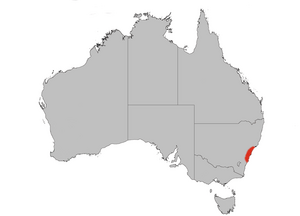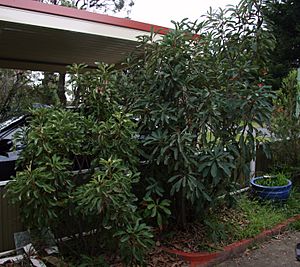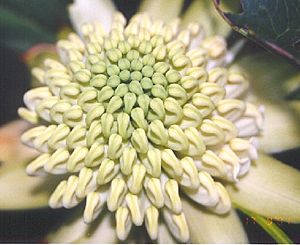New South Wales waratah facts for kids
Quick facts for kids New South Wales waratah |
|
|---|---|
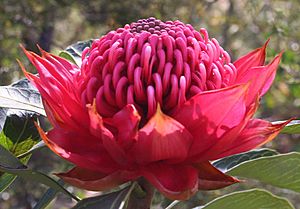 |
|
| Telopea speciosissima flowerhead with florets opening from the edges towards the centre, Blue Mountains, Australia | |
| Scientific classification | |
| Genus: |
Telopea
|
| Species: |
speciosissima
|
| Synonyms | |
|
|
The Telopea speciosissima, often called the New South Wales waratah or just waratah, is a large shrub from the plant family Proteaceae. It grows only in New South Wales, Australia. This beautiful plant is the official floral emblem of that state. There are no known subspecies, but a very similar plant, Telopea aspera, was recently identified as a separate species.
Waratahs are shrubs that can grow up to 3 or 4 metres (10 to 13 feet) tall and 2 metres (7 feet) wide. They have dark green leaves. Several stems grow from a special woody base called a lignotuber. This plant is famous for its amazing large red flowerheads that bloom in spring. Each flowerhead has hundreds of tiny individual flowers. Small animals like the eastern pygmy possum and birds such as honeyeaters love to visit these flowers. Various insects also come to feed on them.
Because it is the floral emblem of New South Wales, the waratah has been used a lot in art, buildings, and advertisements. This has been especially true since Australia became a federation. Waratahs are grown in many countries to be sold as cut flowers. People also grow them in their home gardens. They need soil that drains well but stays moist. However, waratahs can get various fungal diseases and pests. There are many different types, called cultivars, with red, pink, and even white flowers. Plant experts have also created hybrids by mixing waratahs with T. oreades and T. mongaensis. These hybrids can handle cold, shade, and heavier soils better.
Contents
Discover the Waratah's Look
The New South Wales waratah is a tall, upright shrub that can reach 3 to 4 metres (10 to 13 feet) in height. It has one or more stems that grow straight up from a large woody base called a lignotuber. These stems don't have many branches. After the flowers bloom in late spring, new shoots grow, often from the old flowerheads.
The leaves are dark green and grow alternately along the stem. They usually have coarse, jagged edges and are about 13 to 25 centimetres (5 to 10 inches) long. The flowerheads start to grow over winter, surrounded by leafy bracts. In early spring, they swell and then open to show their amazing flowers. The exact time they bloom changes depending on where they are in New South Wales. Some can start as early as August in the north, while others finish in November in the cooler, higher areas in the south. Sometimes, a few flowers might even appear around March in autumn.
Each domed flowerhead is crimson red and measures about 7 to 10 centimetres (3 to 4 inches) across. It can hold up to 250 individual flowers. These flowerheads are cupped by a ring of leafy bracts that are also red and about 5 to 7 centimetres (2 to 3 inches) long. Sometimes, waratahs can look a bit different. Some flowerheads might be more round or cone-shaped instead of domed. The bracts might also be whitish or very dark red. The tips of the stigmas on some flowerheads can be whitish, which stands out against the red.
A waratah flowerhead takes about two weeks to grow to its full size after it first appears from the bracts. It then stays fresh for another two weeks before the flowers start to fade and fall. At first, the tiny individual flowers, called florets, stay closed, making the flowerhead look compact. Then, they mature and split open, showing the stigma, style, and anther. The anther sits right next to the stigma at the end of the style. The florets on the outside of the flowerhead open first, and then the opening moves towards the centre. This makes the centre of the flowerhead look darker and more open, which helps attract birds and insects. The ovary is at the base of the style, on a stalk called the gynophore. This is where the seed pods will grow from. There is also a crescent-shaped nectary at the base of the gynophore, which produces sweet nectar.
Waratah Seed Pods
The seed pods grow to be about 8 to 15 centimetres (3 to 6 inches) long. As they get older, they change colour from green to yellow, and finally to a rusty red-brown. The pods become tough and leathery before they split open in early winter. Inside, the pods hold winged seeds. In the wild, usually only two or three seed pods grow per flowerhead. However, on cultivated plants, there can be anywhere from 5 to 50 pods.
Naming the Waratah
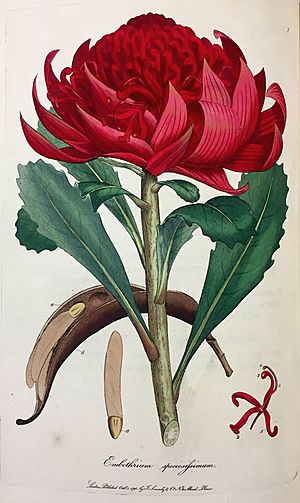
The Telopea speciosissima, or New South Wales Waratah, was first described by a botanist named James Edward Smith in 1793. He wrote about it in his book A Specimen of the Botany of New Holland, using "very fine dried specimens" sent by Mr. White. Smith gave the plant its first scientific name, Embothrium speciosissimum. The second part of the name, speciosissima, comes from a Latin word meaning "very beautiful" or "most beautiful".
Later, in 1809, Robert Brown suggested putting it in its own group, or genus, called Telopea. This name was officially published in 1810. The common name waratah comes from the Eora Aboriginal people, who were the first inhabitants of the Sydney area. Other Aboriginal names for the plant include mooloone and mewah.
Telopea speciosissima is one of five species in the Telopea genus, all found in southeastern Australia. Its closest relative is the similar Gibraltar Range waratah (T. aspera). This plant, found in northern New South Wales, was only recognized as a separate species in 1995. Before that, people thought it was just a different type of T. speciosissima.
Where Waratahs Grow
This plant grows naturally in New South Wales, Australia. You can find it from the Watagan Mountains down to Ulladulla. It is quite common in the Central Coast region. Waratahs usually grow as shrubs under taller trees in open forests. They prefer sandy soils and areas that get a lot of rain, about 1200 mm (47 inches) per year. The shade from eucalyptus trees reduces the sunlight by about 30%.
Much of where the waratah grows is in the Sydney Basin. This area has one of the largest human populations and a lot of development in Australia. It's not clear how this development and frequent bushfires affect the waratah's genes. Even though many populations are protected in National Parks, most are small, with fewer than 200 plants. They are often found close to cities and towns.
How Waratahs Survive and Thrive
The waratah is a special plant that relies on fire to help it grow and spread. After a bushfire, it flowers and releases its seeds. This helps the plant take advantage of the good growing conditions that come after a fire. Among the woody plants in southeastern Australia that can regrow after fires, the waratah is one of the slowest to produce new seedlings. It takes at least two years.
The waratah regrows from its lignotuber, which is a swollen woody base mostly hidden underground. This lignotuber stores energy and nutrients. It helps new shoots grow quickly after a bushfire. About two years after a fire, waratahs become a main plant in the undergrowth. However, they are later overtaken by slower-growing plants like banksias and wattles. Fire also helps to get rid of diseases and pests. After a fire, waratahs can produce many flowers.

The bright colour and noticeable position of the waratah's flowers suggest that birds help pollinate them. This has likely been happening for over 60 million years. Honeyeaters, especially the New Holland honeyeater and the Crescent honeyeater, often visit the flowers. The eastern pygmy possum also looks for food among the flowerheads. Waratahs need pollen from other waratah plants to successfully reproduce.
Growing Waratahs in Gardens
The New South Wales waratah was a popular garden plant in the early 1900s. It was brought to the United Kingdom very early, in 1789. By the 1940s, people started to worry about too many waratahs being picked from the wild. Percy Parry, a plant expert, came up with the idea of "Preservation by Cultivation." He started growing waratahs and other native plants for sale. This led to rules about collecting wildflowers from the wild.
Today, New South Wales waratahs are grown for sale in Australia, New Zealand, Israel, and Hawaii. One challenge for commercial growers is that the flowering season in any one place is short, usually about five weeks. However, by growing plants in different places, the season for cut flowers can be made longer. A cut waratah flower can last for 10 to 14 days in a vase.
Even though waratahs grow naturally in deep sandy soils, they can adapt to other deep, well-drained soils. Slopes can help with drainage. Waratahs flower best in full sun, even though they naturally grow in woodlands. They can handle the dappled shade from eucalyptus trees. Cutting back the plant a lot after it flowers helps it grow stronger and produce more flowers next season. Waratah flowers can be easily damaged by wind, so they benefit from some protection. These beautiful blooms also attract birds to your garden. You can easily grow new waratahs from fresh seed. However, if you want a specific type (a cultivar), you need to grow it from cuttings to make sure it's exactly the same as the parent plant.
Challenges for Waratahs
Several types of fungi can infect the roots of waratahs, making the plants sick or even killing them. Common signs include yellow leaves, wilting, blackening, or parts of the plant dying back. The most common problem is a soil-borne water mold called Phytophthora cinnamomi. This mold seems to cause more trouble for cultivated plants than for wild ones. Large plantings at the Royal Botanic Gardens in Sydney were badly affected by this disease.
Insects can also cause problems. The larvae of the Macadamia leafminer, a type of moth, burrow into and disfigure the waratah's leaves. This mainly lowers the value of cut flowers. More serious is the larger caterpillar of another moth, the Macadamia twig girdler. This caterpillar can burrow into and damage the developing flowerhead.
Different Types of Waratahs
Many natural variations of Telopea speciosissima have been chosen and grown for gardens. Here are a few examples:
- Telopea 'Brimstone Blush' is a smaller shrub, growing to about 1 metre (3 feet) tall. It has a round flowerhead with pink and white styles and dark red bracts.
- Telopea 'Cardinal' is known for its large, dome-shaped, cardinal red flowerheads. These blooms last a long time in a vase.
- Telopea 'Corroboree' has compact flowerheads and grows strongly. It is mainly grown for the cut flower industry.
- Telopea 'Fire and Brimstone' is a strong-growing type with large, cone-shaped flowerheads. It can reach 3–4 metres (10–13 feet) tall. Its blooms last a long time, making it good for cut flowers.
- Telopea 'Galaxy' has pinkish-red flowers with white tips and large bracts around them.
- Telopea 'Olympic Flame' has noticeable bracts around its flowerheads and flowers early in spring.
- Telopea 'Parry's Dream' is a strong plant with red-pink flowerheads surrounded by pink bracts.
- Telopea 'Shade of Pale' is a unique pale-pink flowered waratah. It doesn't grow as strongly as the main species.
- Telopea 'Sunflare' is an early-flowering type with large leaves. It has red flowerheads with white-tipped styles.
- Telopea 'Wirrimbirra White' is a rare white waratah. It was brought into cultivation in 1972 from a plant found near Robertson. Its buds are pale green and open to a creamy-white flowerhead. It is not as strong as the main species and can be damaged by borers and the Macadamia twig girdler.
Hybrid Waratahs
Plant experts have also created hybrid waratahs by crossing Telopea speciosissima with other Telopea species. These hybrids are often more tolerant of cold or shade, making them suitable for cooler climates like Canberra or Melbourne.
- Telopea 'Braidwood Brilliant' is a hybrid that can handle frost well. It is a shrub up to 3 metres (10 feet) tall with red blooms. It grows well in cooler places.
- Telopea 'Canberry Coronet' is another hybrid made for cold tolerance. It has red flowerheads and is a larger plant, reaching 3–4 metres (10–13 feet) high.
- Telopea 'Champagne' is a hybrid with creamy yellow flowerheads that appear from October to December.
- Telopea 'Golden Globe' is a larger hybrid, also with creamy yellow flowers. It has been sold as 'Shady Lady Yellow'.
- Telopea 'Shady Lady' is a larger shrub that can grow up to 5 metres (16 feet) tall. It is a hybrid that tolerates more shade. It grows strongly and is more reliable in temperate and subtropical areas. There are different colour forms like 'Shady Lady Crimson', 'Shady Lady Red', and 'Shady Lady Pink'.
- Telopea 'Shady Lady White' is a white hybrid.
See also
 In Spanish: Telopea speciosissima para niños
In Spanish: Telopea speciosissima para niños



